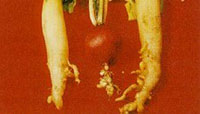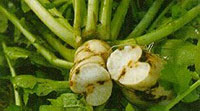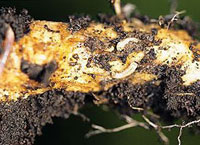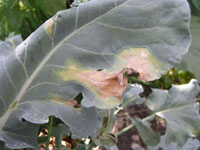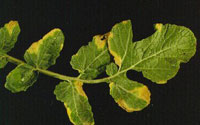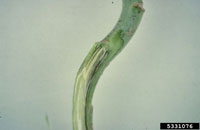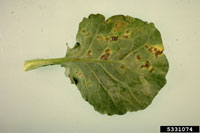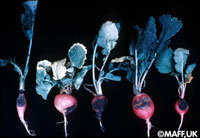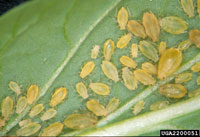Extension > Garden > Diagnose a problem > What's wrong with my plant? > Vegetable > Radish >Leaves yellow and wilt
Radish > Leaves > Leaves yellow and wilt
1 of 5
Club root
Plasmodiophora brassicae
- Roots are swollen into large spindle shaped tumor like galls
- Leaves turn pale yellow, wilt during hot, sunny days, and recover at night
- Young plants may die
- Common in wet soils with a low pH (acidic)
- More information on Club Root
2 of 5
Cabbage maggot
Delia radicum
- Chewing and tunneling in roots is present
- Feeding may cause deformed roots
- Plants may appear yellow and wilted
- Maggots may be present; they are carrot-shaped, legless, and cream colored
- Present in early May – mid June
3 of 5
Black rot
Xanthomonas campestris
- Yellow V-shaped lesions develop on margin of leaves, the point of the v follows a vein towards the base of the leaf
- As infection continues, leaves wilt, turn yellow and eventually turn brown and die
- Black veins can be seen in infected leaves, petioles and stems
- Disease favored by hot, humid conditions
- More information on Black Rot
4 of 5
Downy mildew
Peronospora parasitica
- Angular yellow spots on leaves that eventually grow into tan papery areas with a yellow border
- Fuzzy white to gray fungal growth can be seen on the underside of the leaves
- Dark brown to black sunken area on the upper half of the radish root, center of root remains white
- Skin on the root may be rough, corky and cracked
- Common in cool wet weather
- More information on Downy Mildew
5 of 5
Cabbage aphid, green peach aphid, and turnip aphid
Brevicoryne brassicae, Myzus persicae, Lipaphis erysimi
- When large numbers are present, leaves can become yellow
- 1/16-1/8 inch long, soft-bodied and pear-shaped
- Aphids are present throughout the growing season
- More information on Aphids



